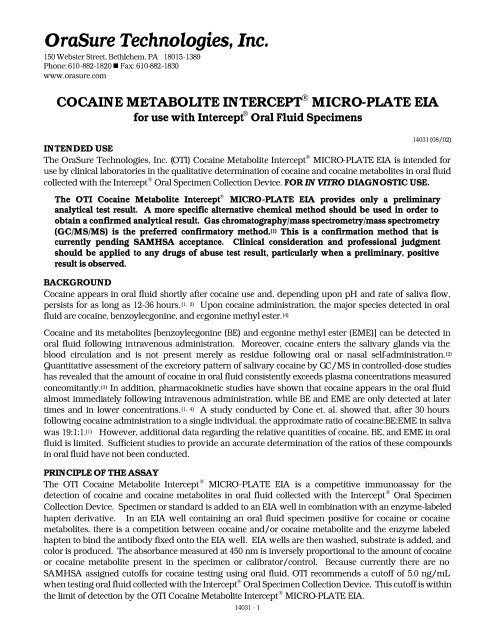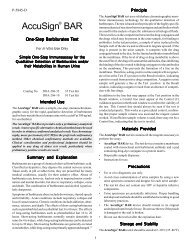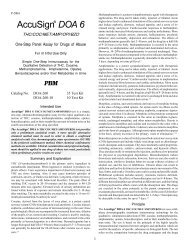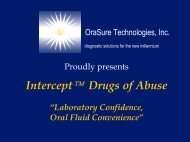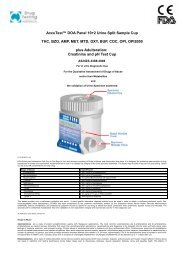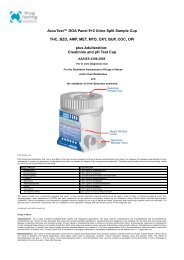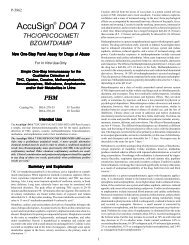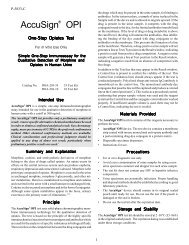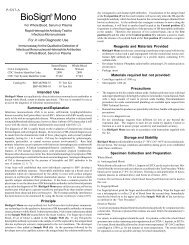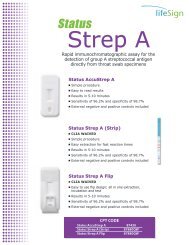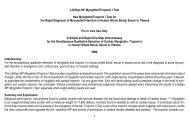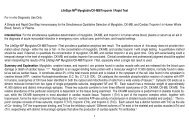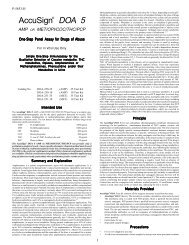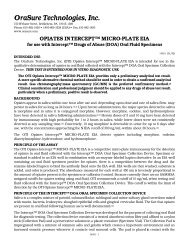Intercept COC.pdf - Drug Testing
Intercept COC.pdf - Drug Testing
Intercept COC.pdf - Drug Testing
You also want an ePaper? Increase the reach of your titles
YUMPU automatically turns print PDFs into web optimized ePapers that Google loves.
OraSure Technologies, Inc.150 Webster Street, Bethlehem, PA 18015-1389Phone: 610-882-1820 • Fax: 610-882-1830www.orasure.com<strong>COC</strong>AINE METABOLITE INTERCEPT MICRO-PLATE EIAfor use with <strong>Intercept</strong> Oral Fluid Specimens14031 - 114031 (08/02)INTENDED USEThe OraSure Technologies, Inc. (OTI) Cocaine Metabolite <strong>Intercept</strong> ® MICRO-PLATE EIA is intended foruse by clinical laboratories in the qualitative determination of cocaine and cocaine metabolites in oral fluidcollected with the <strong>Intercept</strong> ® Oral Specimen Collection Device. FOR IN VITRO DIAGNOSTIC USE.The OTI Cocaine Metabolite <strong>Intercept</strong> MICRO-PLATE EIA provides only a preliminaryanalytical test result. A more specific alternative chemical method should be used in order toobtain a confirmed analytical result. Gas chromatography/mass spectrometry/mass spectrometry(GC/MS/MS) is the preferred confirmatory method. (1) This is a confirmation method that iscurrently pending SAMHSA acceptance. Clinical consideration and professional judgmentshould be applied to any drugs of abuse test result, particularly when a preliminary, positiveresult is observed.BACKGROUNDCocaine appears in oral fluid shortly after cocaine use and, depending upon pH and rate of saliva flow,persists for as long as 12-36 hours. (1, 2) Upon cocaine administration, the major species detected in oralfluid are cocaine, benzoylecgonine, and ecgonine methyl ester. (4)Cocaine and its metabolites [benzoylecgonine (BE) and ecgonine methyl ester (EME)] can be detected inoral fluid following intravenous administration. Moreover, cocaine enters the salivary glands via theblood circulation and is not present merely as residue following oral or nasal self-administration. (2)Quantitative assessment of the excretory pattern of salivary cocaine by GC/MS in controlled-dose studieshas revealed that the amount of cocaine in oral fluid consistently exceeds plasma concentrations measuredconcomitantly. (3) In addition, pharmacokinetic studies have shown that cocaine appears in the oral fluidalmost immediately following intravenous administration, while BE and EME are only detected at latertimes and in lower concentrations. (1, 4) A study conducted by Cone et. al. showed that, after 30 hoursfollowing cocaine administration to a single individual, the approximate ratio of cocaine:BE:EME in salivawas 19:1:1. (1) However, additional data regarding the relative quantities of cocaine, BE, and EME in oralfluid is limited. Sufficient studies to provide an accurate determination of the ratios of these compoundsin oral fluid have not been conducted.PRINCIPLE OF THE ASSAYThe OTI Cocaine Metabolite <strong>Intercept</strong> ® MICRO-PLATE EIA is a competitive immunoassay for thedetection of cocaine and cocaine metabolites in oral fluid collected with the <strong>Intercept</strong> ® Oral SpecimenCollection Device. Specimen or standard is added to an EIA well in combination with an enzyme-labeledhapten derivative. In an EIA well containing an oral fluid specimen positive for cocaine or cocainemetabolites, there is a competition between cocaine and/or cocaine metabolite and the enzyme labeledhapten to bind the antibody fixed onto the EIA well. EIA wells are then washed, substrate is added, andcolor is produced. The absorbance measured at 450 nm is inversely proportional to the amount of cocaineor cocaine metabolite present in the specimen or calibrator/control. Because currently there are noSAMHSA assigned cutoffs for cocaine testing using oral fluid, OTI recommends a cutoff of 5.0 ng/mLwhen testing oral fluid collected with the <strong>Intercept</strong> ® Oral Specimen Collection Device. This cutoff is withinthe limit of detection by the OTI Cocaine Metabolite <strong>Intercept</strong> ® MICRO-PLATE EIA.
PRINCIPLE OF THE INTERCEPT ORAL SPECIMEN COLLECTION DEVICESaliva is a complex mixture of parotid, submandibular, sublingual and minor salivary gland secretionsmixed with mucin, bacteria, leukocytes, sloughed epithelial cells and gingival crevicular fluid. (5) The factthat cocaine and cocaine metabolites are present in oral fluid following human use has beendocumented. (3)The <strong>Intercept</strong> ® Oral Specimen Collection Device was developed for the purpose of collecting oral fluid fordiagnostic testing. The collection device consists of a treated absorbent cotton fiber pad affixed to a nylonstick (Collection Pad) and a preservative solution in a plastic container (Specimen Vial). The CollectionPad is impregnated with a mixture of salts and gelatin which creates a hypertonic environment and anincrease osmotic pressure wherever it contact oral mucosal cells. The pad is placed in contact with thegingival mucosa (between the lower gum and cheek) which enhances the flow of mucosal transudateacross the mucosal surfaces onto the absorptive cotton fibers of the pad. Following the collection period,the Collection Pad is placed into a vial containing a preservative solution which serves to inhibit thegrowth of oral microorganisms recovered on the Collection Pad. The vial is sealed with a plastic cap andtransported to a laboratory for processing and testing. Following processing, a fluid containing a mixtureof mucosal transudate, saliva components and the preservative solution is recovered which is suitable fortesting for the presence of cocaine an cocaine metabolites in the OTI Cocaine Metabolite <strong>Intercept</strong> ®MICRO-PLATE EIA. Refer to the <strong>Intercept</strong> ® Oral Specimen Collection Device product insert for specificinstructions on the proper collection, handling, and adequacy of oral fluid samples.KIT COMPONENTSAnti-Cocaine Metabolite Coated Plate – Mouse anti-benzoylecgoninemonoclonal antibody immobilized on a polystyrene plate supplied in dryform.Enzyme Conjugate - Lyophilized horseradish peroxidase labeled with abenzoylecgonine derivative.Conjugate Diluent - Protein matrix of bovine serum with proteinstabilizers.Catalog No. Catalog No.1122IB 1122IC480 Test Kit 9600 Test KitMin. Qty. Min. Qty.5 1001 160 mL 750 mLSubstrate Reagent - One bottle containing 3,3', 5,5' tetramethylbenzidine. 60 mL 1 LStopping Reagent - Each bottle contains 2 N sulfuric acid. 60 mL 1 LOral Fluid Negative Calibrator – Oral Fluid Diluent negative for2 mL 16 mLbenzoylecgonine.Oral Fluid Negative Control – Oral Fluid Diluent containing 2.5 ng/mL 2 mL 16 mL(v/v) benzoylecgonine.Oral Fluid Cutoff Calibrator – Oral Fluid Diluent containing 5.0 ng/mL 2 mL 16 mL(v/v) benzoylecgonine.Oral Fluid Positive Control – Oral Fluid Diluent containing 10 ng/mL(v/v) benzoylecgonine.2 mL 16 mLWARNINGS AND PRECAUTIONS1. The handling of food or drink near the kit reagents is NOT recommended.2. Proper handling of all reagents is strongly advised. It is suggested that disposable materials are usedto avoid contamination of Substrate Reagent. Discard Substrate Reagent if obvious blue colordevelops.3. Do NOT mouth pipet reagents. Handle all specimens and reagents as if potentially infectious.4. Keep all containers closed when not in use to avoid microbial contamination.5. Do NOT add sodium azide to samples as a preservative.6. Do NOT use reagents past the expiration date.14031 - 2
7. Do NOT mix reagents from different kits or manufacturers.8. Do NOT freeze reagents.9. It is suggested that all OTI reagents be kept out of direct sunlight whenever possible.10. Stopping Reagent is corrosive; handle with care.STORAGE/STABILITY OF THE OTI <strong>COC</strong>AINE METABOLITE INTERCEPT MICRO-PLATE EIAStore all reagents at 2-8°C until the expiration date indicated on the kit label.STORAGE/STABILITY OF THE INTERCEPT ORAL SPECIMENSOral fluid specimens may be stored at 4°C (39°F) to 37°C (98°F) for a maximum of 21 days. Specimensmust be tested in the OTI Cocaine Metabolite <strong>Intercept</strong> ® MICRO-PLATE EIA no later than 21 daysfollowing specimen collection, assuming that they have been maintained between 4°C and 37°C prior totesting. Specimens may be stored in either the original specimen storage vial or may be maintained as aprocessed fluid while being stored in a separate storage tube.INTERCEPT SPECIMEN PROCESSING PROCEDUREMATERIALS REQUIRED BUT NOT PROVIDED1. Tubes suitable for centrifuging <strong>Intercept</strong> ® Specimen Vials.2. Centrifuge capable of 600 - 800 x g.PROCEDURE (Refer to <strong>Intercept</strong> insert for collection, storage, and shipping instructions)1. Record the specimen identification number from the <strong>Intercept</strong> ® Specimen Vial.2. Ensure that the specimen is within acceptable dating for testing, i.e. ≤ 21 days from the time ofcollection.3. Hold the vial upright with the tip pointed up.4. Move the pad away from the vial tip by gently tapping the vial.5. Break the pointed tip of the vial off with your thumb.6. Place a tube over the vial and invert the tube and vial.7. Centrifuge at 600 - 800 x g for 15 minutes.8. Assay or store the resulting eluate according to the procedures described herein.9. A minimum of 0.7 mL of the eluate sample is required. This can be determined by centrifugation ofthe samples into graduated containers or by direct pipetting with a calibrated pipet adjusted to thespecified volume.10. If the minimum volume requirement is not met, a new sample should be collected. If this is notpossible, a warning should accompany any data generated indicating that an insufficient amount ofsample was collected and that this may affect the accuracy of the final result.ASSAY PROCEDUREMATERIALS REQUIRED BUT NOT PROVIDED1. Semi-automated pipets (50 and 100 microliters) with tips.2. Micro-plate reader capable of reading at a dual wavelength of 450 and 630 nm.3. Micro-plate washer.4. Working dilution of Stock Enzyme Conjugate (See “Working Reagent Preparation” instructionsbelow).5. <strong>Intercept</strong> ® eluate sample(s) - 0.7 mL minimum.WORKING REAGENT PREPARATION1. Using a calibrated pipet, add 2 mL of Conjugate Diluent to the vial of Lyophilized Stock EnzymeConjugate.14031 - 3
2. Replace the stopper and gently mix the contents of the vial by inversion for 10 minutes.3. Using a calibrated pipet, add the volume of reconstituted Stock Enzyme Conjugate specified on the"Lyophilized Stock Enzyme Conjugate Dilution Instructions" for this lot to the Conjugate Diluentbottle.4. Replace the lid on the bottle and gently mix the contents by inversion for 1 minute. Allow the reagentto equilibrate for 30 minutes at room temperature or overnight at 2-8°C.5. The working dilution of Stock Enzyme Conjugate is stable for 6 months and may be used in the OTICocaine Metabolite <strong>Intercept</strong> ® MICRO-PLATE EIA as needed.PROCEDURE - Note: Allow all reagents and samples to come to room temperature (15-27 C) before use.1. At the discretion of the operator, all samples, calibrators and controls may be tested in duplicate. Theinclusion of calibrators and controls is recommended on each new plate.2. Add 50 microliters of sample, calibrator, or control to each well. Label wells appropriately.3. Add 50 microliters of the working dilution of Stock Enzyme Conjugate to each test well.4. Incubate for 30 minutes at room temperature (15-27°C) in the dark.5. Wash the plate using a suitable plate washer. As a general rule, wash each well six (6) times with 300microliters of distilled water.6. Add 100 microliters of Substrate Reagent to each well and incubate 30 minutes at room temperature(15-27°C) in the dark.7. Add 100 microliters of Stopping Reagent to each well.8. Measure the absorbance at 450 nm within 15 minutes of stopping the reaction.INTERPRETATIONPositive result:Any sample with an absorbance less than or equal to the Oral Fluid Cutoff Calibrator isconsidered a positive.Negative result: Any sample with an absorbance greater than the Oral Fluid Cutoff Calibrator isconsidered a negative.When interpreting duplicate results, the operator must be aware of several factors which may influenceassay results. These include precise pipetting of specimens and reagents, effective washing of plates, andproperly calibrated and maintained instrumentation. Duplicate sample results with a difference of 10%or greater between absorbance values should be retested.QUALITY CONTROLOTI provides Negative and Positive Controls to monitor the daily performance of the OTI CocaineMetabolite <strong>Intercept</strong> ® MICRO-PLATE EIA. The Oral Fluid Negative Control must have an absorbancegreater than the Oral Fluid Cutoff Calibrator, while the Oral Fluid Positive Control must always have anabsorbance less than the Oral Fluid Cutoff Calibrator. Additional controls may be tested according toguidelines or requirements of local, state, and/or federal regulations or accrediting organizations.The testing laboratory should also monitor the percent displacement to cutoff between the Oral FluidCutoff Calibrator and the Oral Fluid Negative Calibrator (formula listed below). Refer to the LotSpecification Sheet included in each kit for the expected results and acceptable percent displacementcriteria. If the kit is not meeting these minimum criteria, contact OTI Technical Service for assistance.A%Displacement to Cutoff=450Value(Negative Calibrator ) - A450Value(Cutoff Calibrator )x100A450Value( Negative Calibrator)Failure to follow these QC criteria in the OTI Cocaine Metabolite <strong>Intercept</strong> ® MICRO-PLATE EIA maycause poor results or otherwise compromise the integrity of the assay.14031 - 4
LIMITATIONS OF THE PROCEDUREThis assay is designed for use with oral fluid collected with the <strong>Intercept</strong> ® Oral Specimen CollectionDevice. Other samples may produce variable results, and their use is not recommended. In addition,final pH levels of an oral fluid specimen that are £ 5.0 may produce false positive results in the assay.Finally, it is not possible to document all possible effects of oral activities such as eating food, chewinggum, drinking and dental care activities. Therefore, all possible activities that may affect how readilybenzoylecgonine is eliminated from saliva to below the cutoff level have not been fully evaluated.PERFORMANCE CHARACTERISTICS OF ORAL FLUID SPECIMENSAnalytical Sensitivity/Limit Of Detection - The Limit of Detection (LOD) was defined from the signalto-noiseratio at the zero-drug concentration as the mean zero absorbance (Ao) minus the noise timesthree (LOD = Ao - 3 SD). The LOD was determined by obtaining the average absorbance value forsixty-four (64) readings of blank Oral Fluid Diluent and calculating the standard deviation (SD) and3SD of the absorbance. The absorbance value minus 3SD was then extrapolated from the curve andrepresents the sensitivity of the assay. The LOD was calculated to be 1.5 ng/mL.Precision – The precision of the OTI Cocaine Metabolite <strong>Intercept</strong> ® MICRO-PLATE EIA was assessedby testing Oral Fluid Diluent containing 0, 2.5, 5.0, and 7.5 ng/mL benzoylecgonine. The intra-assayprecision was determined by analyzing each level 16 times per run for 4 runs. Inter-assay precisionwas determined by analyzing 2 samples at each level twice per day for 20 days. The results of thistesting are described in the following table:BENZOYLECGONINE(ng/mL)INTRA-ASSAY% CV (n=64)0 3.7 8.02.5 3.4 9.05.0 4.3 9.67.5 7.6 10.5INTER-ASSAY% CV (n=4/day, 20 days)Analytical Specificity/Cross-Reactivity - The following compounds were spiked into Oral Fluid Diluentat a target concentration of 10,000 ng/mL and tested for cross-reactivity. None were found to produce asignal less than or equal to that of the Oral Fluid Cutoff Calibrator.4-Aminophenyl Sulfone Cotinine L-Ephedrine PentobarbitalAcetylsalicylic Acid Cyclizine L-Methamphetamine PhencyclidineAlprazolam D-Amphetamine Lidocaine PhenobarbitalAmobarbital D-Methamphetamine Loperamide PhenylephrineAmpicillin Dextromethorphan Medazepam PhenylpropanolamineAtropine Diacetylmorphine Meperidine Procainamideβ-Phenethylamine Diphenhydramine Methadone ProcaineBuproprion Fenoprofen Metoprolol PseudoephedrineButabarbital Fluoxetine Morphine QuinidineButalbital Gemfibrozil Nalorphine SalbutamolCaffeine Gentisic Acid Naproxen TemazepamChlordiazepoxide Glipizide Niacinamide TheophyllineChlorpromazine Hydrocodone Norchlordiazepoxide TolmetinClonazepam Hydromorphone Nordiazepam ∆ 9 -THCClorazepate Ibuprofen Nystatin ZomepiracCodeine Imipramine Penicillin14031 - 5
The analytical specificity of an immunoassay is defined as the cross-reactivity of substances in the assaywhich are structurally related to the target compound. The percent cross-reactivity of a compound inthe OTI Cocaine Metabolite <strong>Intercept</strong> ® MICRO-PLATE EIA is defined as the apparent benzoylecgonineconcentration divided by the spiked concentration times 100.The cross-reactivity of structurally related compounds was calculated at several spiked concentrationsin Oral Fluid Diluent. The following table indicates the apparent concentration of benzoylecgonine foreach substance at a concentration which cross-reacted in the assay. Note: Benzoylecgonine was usedas the kit standard and, therefore, will exhibit 100% cross-reactivity.CompoundTested Concentration(ng/mL)BenzoylecgonineEquivalents(ng/mL)Cross Reactivity (%)Cocaethylene 1 2.0 200Cocaine 10 6.4 64Ecgonine 1000 4.4 0.4Ecgonine Methyl1000 1.2 0.1EsterBenzoylecgonine 5 5 100It is possible that other substances and/or factors not listed above may interfere with the test and causefalse results, e.g., technical or procedural errors.ACCURACYThe relative sensitivity and specificity of the OTI Cocaine Metabolite <strong>Intercept</strong> ® MICRO-PLATE assaywas determined from 220 oral fluid specimens obtained from clinical laboratories. All samples weretested by EIA and by GC/MS/MS using a 5.0 ng/mL cutoff. The % agreement of the OTI EIA ascompared to GC/MS/MS is shown below:GC/MS/MS of <strong>Intercept</strong> ® Specimens(5.0 ng/mL Cutoff)+ -OTI <strong>Intercept</strong> ® EIA + 46 8(5.0 ng/mL Cutoff) - 7 159% Agreement = 93.2%BIBLIOGRAPHY1. Cone, Edward J., "Saliva <strong>Testing</strong> for <strong>Drug</strong>s of Abuse," Addiction Research Center, National Instituteon <strong>Drug</strong> Abuse, Baltimore, Maryland 21224, 1992.2. Schramm, W., Smith, R.H., and Craig, P.A., "<strong>Drug</strong>s of Abuse in Saliva: A Review," Journal of AnalyticalToxicology, 1992; 16:1-9.3. Thompson, L. K., Yousefnejad, D., Kumor, K., Sherer, M., and Cone, E., "Confirmation of Cocaine inHuman Saliva After Intravenous Use," Journal of Analytical Toxicology, 1987; 11:56-58.4. Kato, K., Hillgrove, M., Weinhold, L., Gorelick, D.A., Darwin, W.D., and Cone, E.J., "Cocaine andMetabolic Excretion in Saliva Under Stimulated and Nonstimulated Conditions," Journal of AnalyticalToxicology, 1993; 17:338-341.5. <strong>Intercept</strong> ® Oral Specimen Collection Device, Package Insert. Manufactured by OraSure Technologies,Inc., Beaverton, OR 97008.Note: Adulteration of reagents, use of instruments without appropriate capabilities, or other failure to followinstructions as set forth in the labeling can affect performance characteristics and stated or implied labelclaims.14031 - 6


